Artists
Lubaina Himid on Creating a Memorial to all the ‘Aunties’ in Her Life
"Make Do and Mend" at the Contemporary Austin is the British artist's first solo show in the American South.
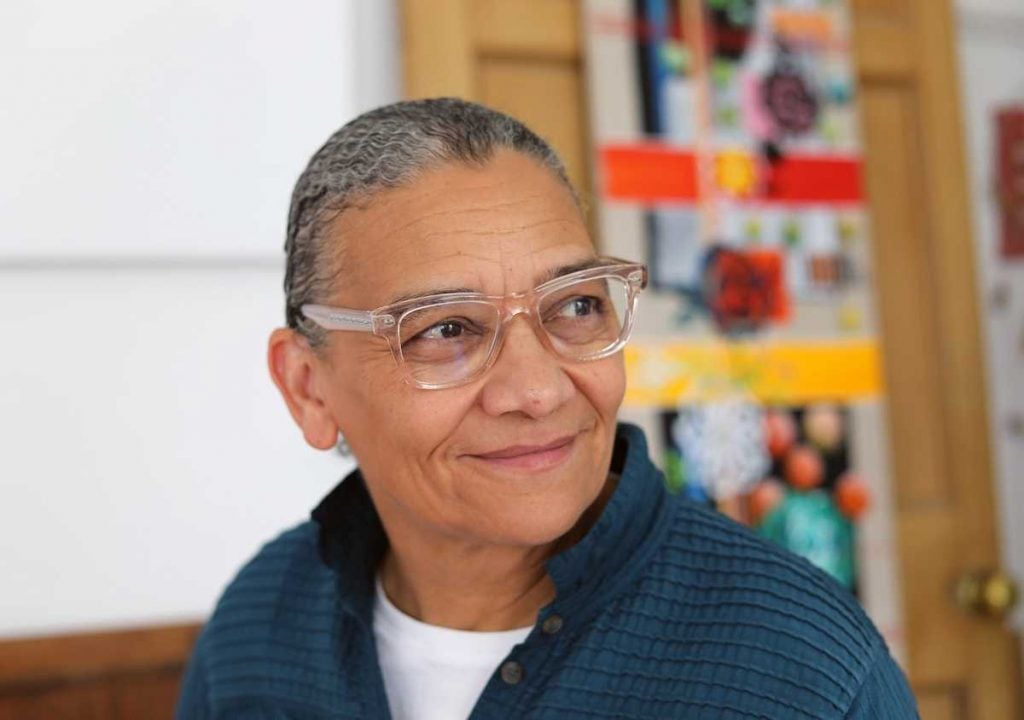
"Make Do and Mend" at the Contemporary Austin is the British artist's first solo show in the American South.

Precious Adesina

On the top floor of a solo exhibition by Lubaina Himid in Austin, Texas, stands more than six dozen women, all around three metres tall. Despite their noticeably different styles, the women aren’t wearing clothes, nor do they have faces or discernible body parts—this is because they’re actually 64 individually painted, narrow wooden planks made of pieces of found wooden objects that she has strategically put together. Himid calls them “aunties.”
“Everybody knows that no two people are the same. They might be made of the same components, but they’re not the same,” she says of the artwork over a video call, noting that aunties (related or not) are those who have the freedom to create their own familial dynamics with others.
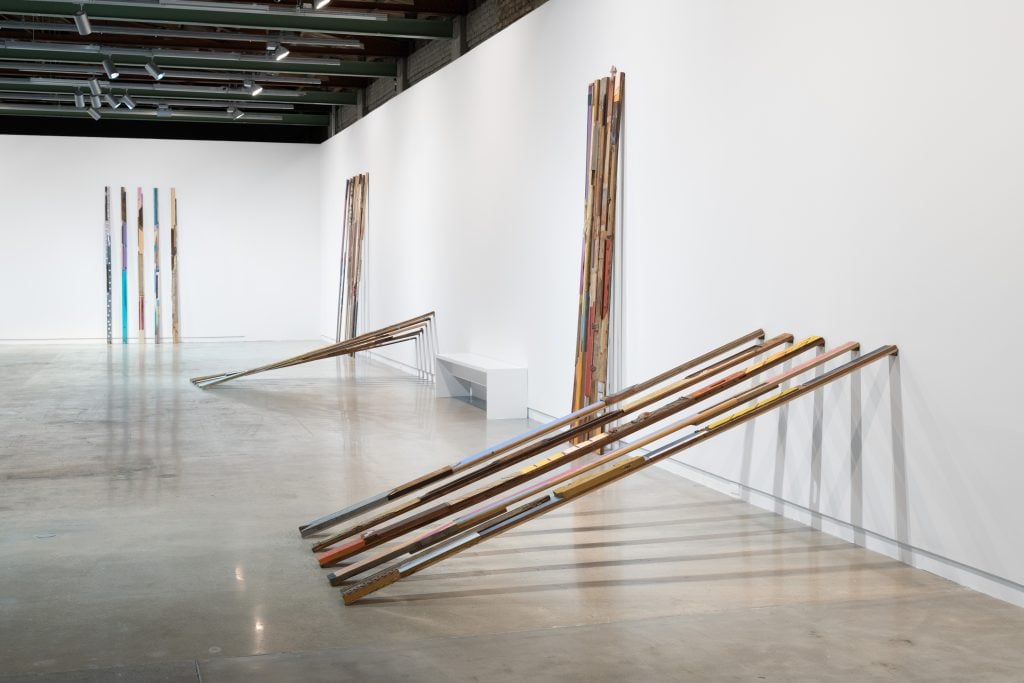
Lubaina Himid, Aunties (2023). Installation view, Lubaina Himid: Make Do and Mend, The Contemporary Austin – Jones Center on Congress Avenue, 2024. Artwork © Lubaina Himid. Courtesy the artist and Hollybush Gardens, London. Image courtesy the Contemporary Austin. Photograph by Alex Boeschenstein.
“I wanted to talk about those women—who I am now one of—that were in and out of our parents or our friends’ parents’ houses; they’re there at weddings, in the market on a Saturday afternoon, just hanging out, giving their opinion about whether she should marry him, or asking whether you’re really going to go out to a party dressed like that,” she said. “Or when they looked after you as a child, they did it differently than how your mother did it.”
The Aunties (2023) is one of two bodies of work currently on show at the Contemporary Austin, a museum which comprises the historic Jones Center in downtown Austin and Laguna Gloria, a fourteen-acre sculpture park. At the Jones Center is the Turner Prize winner’s first solo show in the American South—”Make Do and Mend” will run until July before travelling to the Flag Art Foundation in New York in September. The second set of works is her “Strategy Paintings” series, which contains ten square paintings depicting Black men and women meeting around tables littered with various objects.
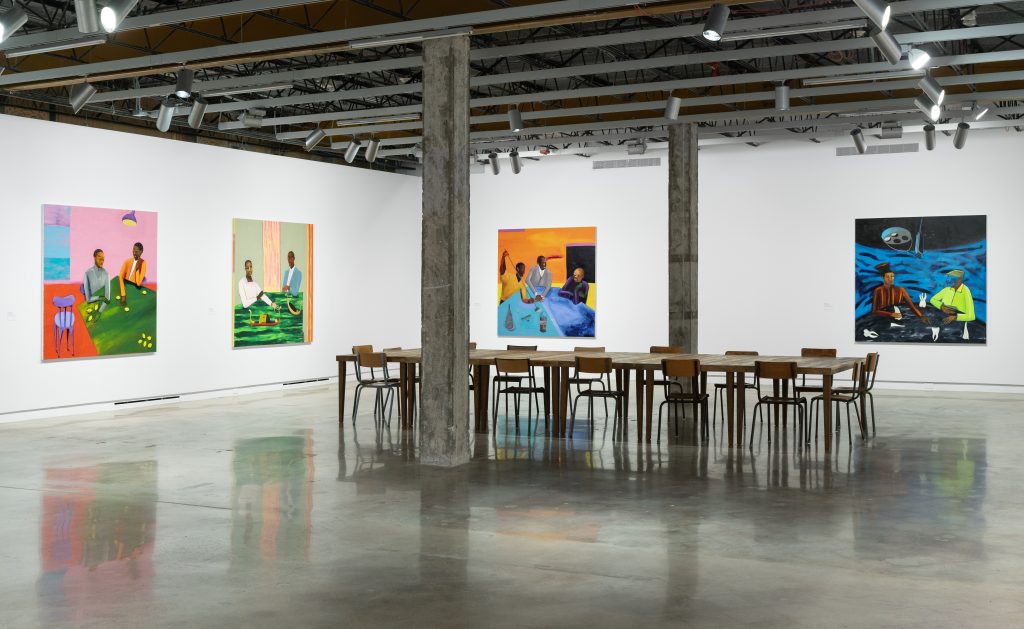
Installation view, Lubaina Himid: Make Do and Mend, the Contemporary Austin – Jones Center on Congress Avenue, 2024. Artwork © Lubaina Himid. Image courtesy The Contemporary Austin. Photograph by Alex Boeschenstein.
“Make Do and Mend” is the product of Himid winning the 2024 Suzanne Deal Booth / FLAG Foundation Art Prize. The highly coveted award acknowledges artists with exceptional work, a strong record of exhibiting at museums and galleries across the globe and someone whom the advisory committee believes deserves more recognition.
“Lubaina Himid’s works center Black figures, history, and experiences, and her pivotal role in the Black British art movement has profoundly shaped our conversations about contemporary art and omissions within art history,” note Alex Klein, head curator at the Contemporary Austin, and assistant curator Julie Le in a joint statement. “In tandem with her incredible expanded painting practice, she is equally inspiring as an advocate for other artists through her work as a curator, historian, and academic.”
For Himid, The Aunties was inspired by her own personal experiences and she describes it as a kind of “memorial” to the aunties in her life—but also in the lives of others.
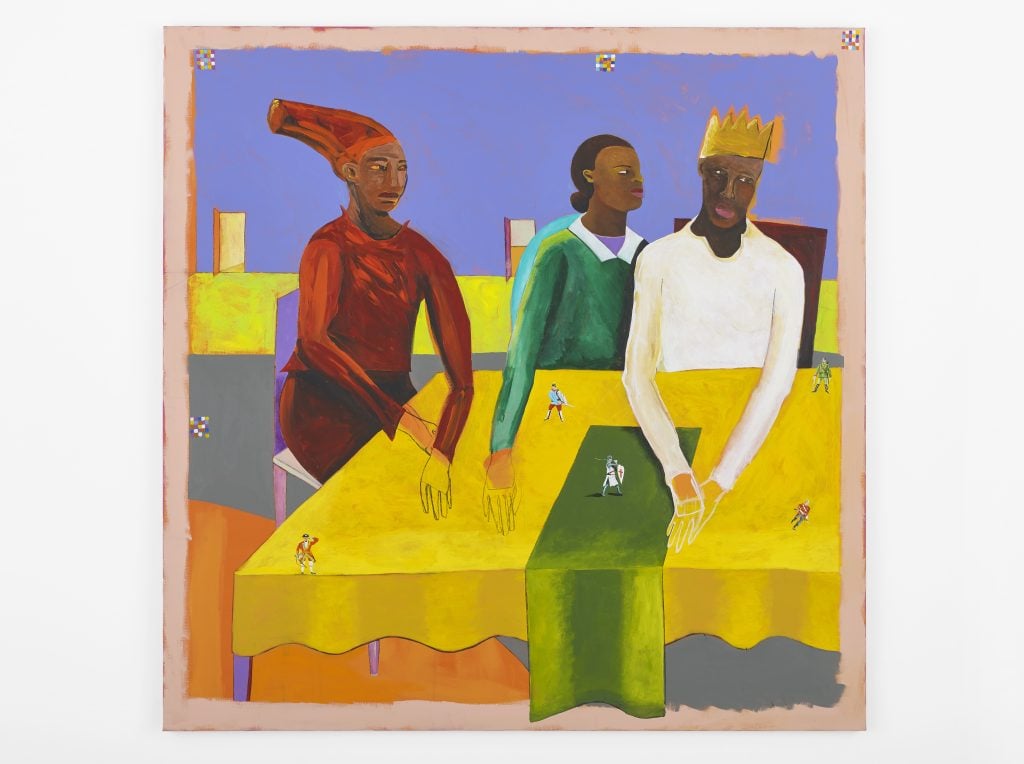
Lubaina Himid Pointless Heroism (2023). Artwork © Lubaina Himid. Courtesy the artist and Hollybush Gardens, London. Image courtesy the artist and Hollybush Gardens, London. Photograph: Andy Keate
“Very often when I don’t have a thing, I paint it into existence,” she says. “I’ve reached an age where all those women—[those] that were hanging out in my mother’s house, or that I was aware of my mother meeting or that were my actual aunties—they’re all dead now.” In various media interviews, the artist, who is 69 years old, has mentioned her mother’s sister, Aunt Betty, whom she grew up with and who taught her to read. “I’ve now realized that I’ve become that for a lot of people—artists or my friend’s children who I’ve known since they were two or three years old,” she says.
Himid has set up The Aunties so the women are in smaller groups. “Sometimes they’re up on the wall, sometimes they’re leaning very low, and I found that when people were in the very big space [at the Jones Center] that they felt free and happy to go up close to them and start to pick out their favorite one.”
She noted that people also eventually started looking for the planks that most reminded them of people they knew and also felt encouraged to think about “what support is or the different roles women play in everyday life,” she says. “When [visitors] thought about the fact they were called the Aunties, they started to think about that whole notion.”
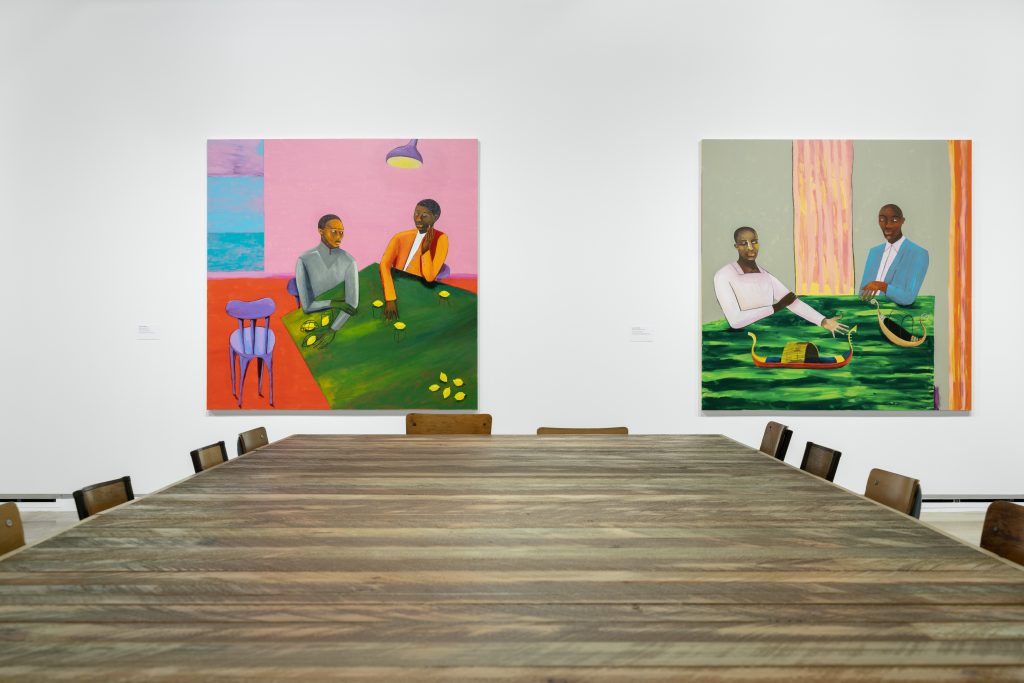
Installation view, Lubaina Himid: Make Do and Mend, the Contemporary Austin – Jones Center on Congress Avenue, 2024. Artwork © Lubaina Himid. Image courtesy The Contemporary Austin. Photograph by Alex Boeschenstein.
At first glance, Himid’s “Strategy Paintings” on the first floor take on a very different note. With the Jones Center only blocks from the Texas State Capitol and made with the museum and its location in mind, “her Strategy Paintings ask us to consider who is at the table when decisions are made,” say Klein and Le.
In the work Bitter Battles (2023), two Black men sitting adjacent to each other appear to be in deep thought as bright yellow lemons are carefully placed across the table in front of them. “The people are wondering what monuments are for, what their point is, what they do, who they are for, why they are there,” Himid explains. “They are using lemons to try to work this out.”
Some of the lemons are placed in bunches in one corner of the table, others are underneath, inside, or on top of various structures that represent monuments that can be found on “pedestals and stands and in squares and in entrances to cities, small towns, and villages all over the world,” says the artist. She mentions that often there is suffering involved in some way when a person is memorialized—it may be that someone achieved something despite suffering or as a result of the suffering of others (she offers a “great” battle as an example).
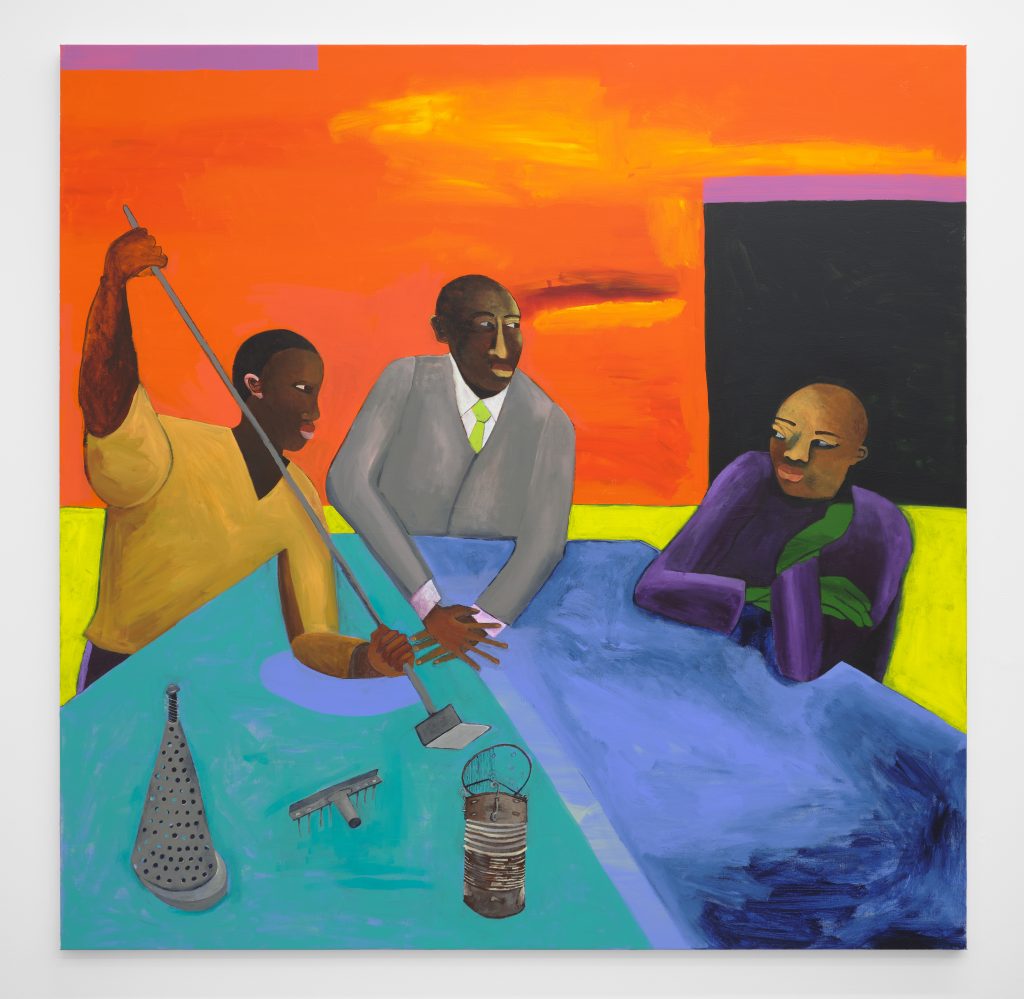
Lubaina Himid Archival Manoeuvres (2023). © Lubaina Himid. Courtesy the artist and Hollybush Gardens, London. Image courtesy the artist and Hollybush Gardens, London. Photograph: Eva Herzog.
“Instead of using words or statistics, they’re using objects,” she says of the figures she depicted in deep discussion. “Across all the ten paintings, I’m continuously trying to use objects to draw an audience into the debate.”
Himid has also placed tables and chairs in the exhibition space so visitors can facilitate their own discussions. “You can book those tables in the morning of any day of the week and bring your own meeting to it,” she says. “We’re usually very used to seeing paintings from a standing-up position in galleries, but when you look at these paintings sitting down, they’re slightly different. You are very aware of people at the table talking as opposed to them being paintings that you’re supposed to be there to look at, and you become part of the conversation yourself.”
Initially, Himid created the two sets of artworks with the intention of them being separate from each other, but while thinking about them in situ for the show, she realized how they linked. The audience completes the work. “For me, [the art] doesn’t start until [visitors] are in the room mucking up the perfection of it, getting in the way of it, being part of it and animating it,” she says. “The similarities [between these two series] are that audiences make both those bodies of work. They bring their aunties into the room, even though they don’t know they’re doing it.”
Lubaina Himid: Make Do and Mend is on view at the Contemporary Austin until July 21, 2024.